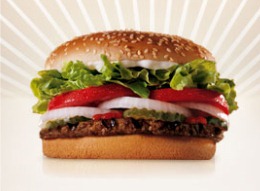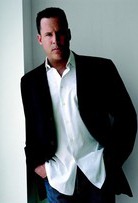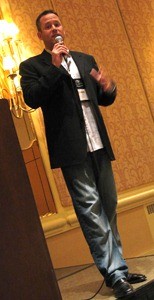By Joe Moore
Yesterday, my blog mate, Kathryn Lilley, discussed market research and why consumers choose one product over another. To continue Kathryn’s theme, I propose the question: Why are people motivated to purchase one book over another? Is it the author? How about the cover art? The cover blurbs from other writers? The title? The synopsis on the back or inside liner?
All of the above are important, that’s for sure. But I believe one of the biggest factors in motivating a purchase of a book is “brand”, or lack of it in the case of not making the purchase.
Why brand? Readers want consistency. Think of food. Everyone knows exactly what a Burger King Whopper tastes like. The Burger King brand is known worldwide because  they found something that people like and they keep repeating it. I can walk into a Burger King anywhere on the planet and I know what to expect. The same goes for McDonalds, Pizza Hut, Starbucks, KFC, Taco Bell, and hundreds of other well established brands. If I crave a Big Mac, there’s only one place to get it.
they found something that people like and they keep repeating it. I can walk into a Burger King anywhere on the planet and I know what to expect. The same goes for McDonalds, Pizza Hut, Starbucks, KFC, Taco Bell, and hundreds of other well established brands. If I crave a Big Mac, there’s only one place to get it.
I think that the same holds true for books. I can pick up the latest James Paterson, Nora Roberts or Clive Cussler novel and I know what to expect. They have established a consistency in their product that has become their brand. As a matter of fact, their names ARE their brands. All you have to do is mention Patterson, Roberts or Cussler, and anyone who has experienced those brands knows what you’re talking about. Just like the Whopper. You don’t have to explain it to someone who’s already had one.
What is brand? For starters, I think of it as a consistent level of expectancy. By that I mean that the customer/reader expects something to happen each time they make a purchase based upon the brand, and it does—every time. If there ever comes a time when it doesn’t, the customer/reader will abandon the product for a replacement—maybe not the first time, but eventually they will move on.
Now I know what you’re thinking. I’m a debut author. I have no brand. Or I only have a couple of books out. Not enough time to establish a brand yet. Ask yourself this: how strong was James Patterson’s brand when he published Along Came A Spider in 1993? Probably not as strong as it is today. He started with a good story, quality writing and a compelling package, and built it into the James Patterson brand combining it with other vital branding items. Branding goes way beyond story content, style, voice, and other writing elements. It involves your book covers, your website, your blog, your marketing collateral, how you dress in public at signings and conferences, how your email signature is worded—in other words, your brand is your message working in tandem with your personal “packaging”. The good news is that today we have even more avenues for building our brand than Mr. Patterson did 16 years ago.
So, how do you create a brand from your message and personal packaging?
Your message is primarily the words that are contained in your books and the words used to describe your books. The packaging is the “framing” of those words. If the message and the packaging are not synchronized, you will create confusion in the marketplace. You control your message by the content of your stories. And it’s important that you work closely with the publicist and marketing department at your publisher to make sure your message matches the message they produce for promoting your books. If it doesn’t, keep working with them until everyone feels that it does.
What about the packaging decisions you can do yourself?
Start with your website. It’s one of the most important parts of your personal packaging. You’re in control of all aspects of its content and construction. Make sure it looks like your books. I know that sounds pretty basic, but you’d be surprised that the only similarity between some author’s websites and their books is that they show a picture of the book cover. For best packaging results, the entire site should have the same visual feel as your cover(s). If you can’t create or capture that yourself, find a professional to do it. Remember, it’s the TOTAL packaging that helps establish your brand.
Now think about the rest of your collateral material such as business cards, post cards, posters, bookmarks, newsletters, bulletins, etc. Do they project your brand? Are they an extension of your book covers and website? Again, if you can’t achieve a totally consistent personal package, find a professional designer that understands branding and packaging. The investment will pay for itself in the long run.
 Make sure you know and understand what you want your brand to be. Understand who you are in relation to your brand. What kind of image do you want to portray? I’m not suggesting you come up with some fake persona and act like someone you’re not. But guess what? Being an author is acting. It’s acting out your brand. It’s your personal packaging.
Make sure you know and understand what you want your brand to be. Understand who you are in relation to your brand. What kind of image do you want to portray? I’m not suggesting you come up with some fake persona and act like someone you’re not. But guess what? Being an author is acting. It’s acting out your brand. It’s your personal packaging.
A great example of this is Vince Flynn. He not only delivers a consistent level of quality in his writing and stories, but when  he appears in public as “Vince Flynn the author” for a signing or conference, he acts out the part. His physical brand is obvious: jeans, shirttail out under a sports jacket. In person, he looks like his cover photo. Remember that the first physical connection a reader has with an author is the photo on the back of a book. That portion of the personal packaging had been set in the readers mind. One day that reader/fan will be at a book signing and in walks the author. The reader has a consistent level of expectancy in all things concerning the author’s brand. If the author understands that, it should all come together. They immediately relate.
he appears in public as “Vince Flynn the author” for a signing or conference, he acts out the part. His physical brand is obvious: jeans, shirttail out under a sports jacket. In person, he looks like his cover photo. Remember that the first physical connection a reader has with an author is the photo on the back of a book. That portion of the personal packaging had been set in the readers mind. One day that reader/fan will be at a book signing and in walks the author. The reader has a consistent level of expectancy in all things concerning the author’s brand. If the author understands that, it should all come together. They immediately relate.
In building your brand, you must consider all of these items working together. The consumer will come to expect it and it’s to your advantage to deliver.
As a writer, do you feel like you have a brand? If you do, is it the one you want? Are you aware of it? Can you think of some other examples of writers who have a consistent, strong brand?

I actually do give some thought to this, especially when I’m going to go out and meet the public. I recently had a new author photo up and I put several of them up on the blog to get people’s opinions. (Very funny). One person said he liked #3 because it made me look like a badass, a guy who could write books about another badass named Derek Stillwater. (My brother pretty much agreed, noting that one picture made me look like I was going to tear the cap off a beer bottle with my teeth just before I beat the crap out of someone–gotta love family).
One writer friend said, “For god sakes, can’t you smile?”
But I’m aware that there is a sense I’m trying to project. Does Barry Eisler come off as an international man of mystery in his pics? Does Dick Francis come off as a kindly English gent? What about GM Ford with his muscle shirt, tattoos, and shaved head?
Some of it just depends on what you’re trying to project. And consistency from the publisher undoubtedly helps, too. If you’re writing thrillers, hopefully the book is called a thriller and not a mystery. (And hopefully your title sounds thriller-ish).
I think I got hurt a bit by this in the past. My book was a thriller. The publisher called it a mystery (even on the book). The titles were The Devil’s Pitchfork and The Serpent’s Kiss, and a number of people asked me if they were horror or paranormal. Obviously there was some unintentional confusion being created in the marketplace. And then there was the author photo of me in a pink flowered muu-muu (just kidding).
Mark, I happen to know that you’re one of the nicest badasses around. But I’m not going to say anything to tarnish your image. I really believe that it doesn’t matter what brand a writer decides to establish as long as it’s consistent across the board. There’s nothing worse that confusion in eyes of the consumer. I mentioned Vince Flynn, but two more writers with strong brands come to mind: David Morrell and Anne Rice. David’s black sports jacket and pants, and collarless dark shirt are his trademarks.
Great topic! I’ve read that authors should “be ourselves” at public events, but I have a special, somewhat showy necklace that I usually wear as a trademark. And then of course I have to dress the rest of me up to go with the necklace. If you’ll pardon the girl talk, I’ll confess that I also get my hair done and wear more makeup at public events. I figure if people have come to see you at an event, they want to see someone who looks like a personality, not someone who’s out walking the dog.
Anne Rice is an interesting example, though. Hasn’t she entirely changed what she writes about?
I was watching a TV biography of Anne Rice, and what struck me is the powerful journey she has been on as a person and as a writer. Evidently she wrote her vampire books after turning away from her faith and religious roots of her youth; later on she experienced a reawakening of faith, and that spiritual renewal has informed her more recent writing. In a way, that makes me think that she’s always had a “brand”–she’s just revealing different phases and facets of it.
Excellent post, Joe. My brand: The Suspense Never Rests. Came up with that in a group brainstorming/branding session with some other writers several years ago.
I’d counsel new writers to a) write what they love to read; b) write the best book possible, and then get to work on their next book, which will also be the best book possible; c) when they are published, work with the publisher on the branding ideas. Until then, worry more about the writing than the branding.
Joe~
Once again, a thought provoking posting. You really do get me thinking about these things. But my thought after finishing your post was, is the tail wagging the dog? Or maybe better said, is this a chicken or egg situation? That is, does the brand make you buy the product or does the product sell itself and the brand is ancillary? I know about the Whopper but I don’t like them so I don’t buy them. Sure, I know what I’d get if I did buy a Whopper but I won’t because, again, I don’t like them. So you can have the strongest brand in the world but if your product sucks and no one likes it, then you aren’t getting ahead.
Which reminds me of another brand – those head-splitting “creditreport.com” commercials. If I owned a handgun, I’d pull an Elvis whenever one of those comes on. But maybe that’s another blog….
Great comments, Mark. I agree that the strongest branding in the world won’t sell a product to someone who tried it and didn’t like it. I’m not a huge fan of the Whooper, either, but I used it as an example of excellent commercial branding. I have noticed, though, that during the lunch and dinner hours, long lines of customers form in thousands of Burger King restaurants around the world to buy Whoopers. So somebody must like them.
To answer your chicken vs. egg questions, I don’t believe anything sells itself. But those products that appear to sell themselves usually have already established a strong brand. What the brand does is reflect consistency in the values that the customer seeks. As writers, we must be aware of branding. We must understand what the customer has come to expect from us based upon previous experiences, and make sure we don’t drop the ball.
It’s certainly something I’ve been thinking about a lot, and I’m finally trying to brand my website. Interesting article. Thanks.
My Brand?
Hrothgar Skull Crusher,Viking meets Andy Taylor, Mayberry PFD.
Tough, yet cuddly and knows how to make a mean lemonade in the midst of carnage.
Hi! Your blog is simply super. you have create a differentiate. Thanks for the sharing this website. it is very useful professional knowledge. Great idea you know about company background. Increasing your web traffic and page views Add, add your website in http://www.directory.itsolusenz.com/